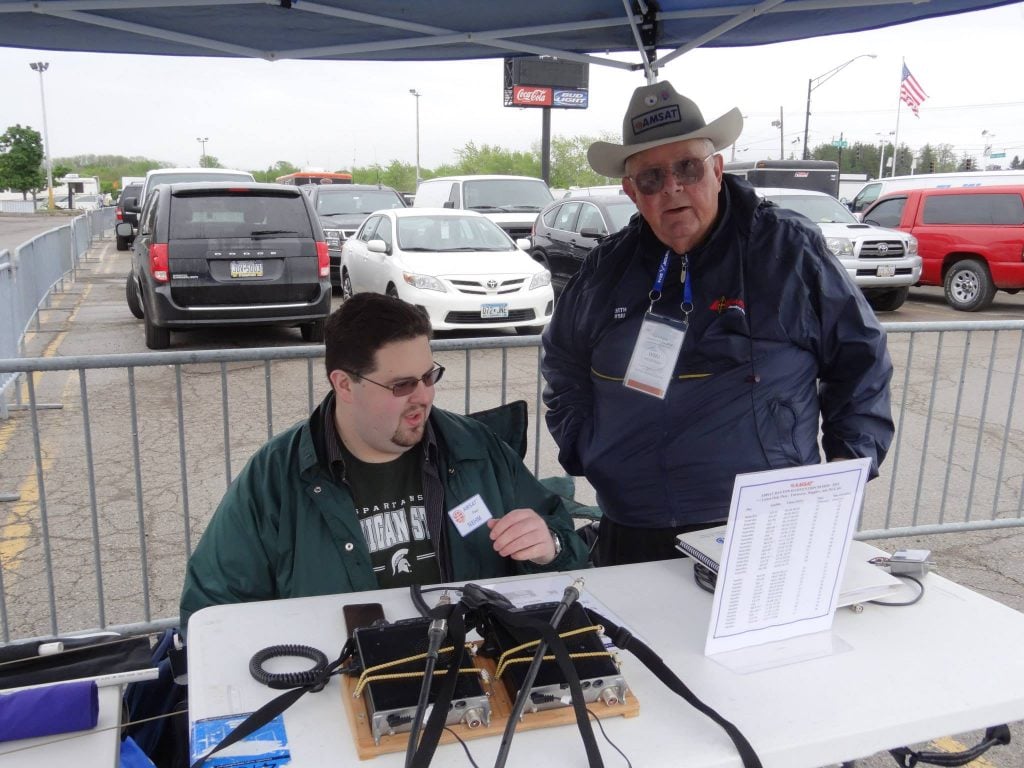AMSAT will again have a demo station at the Dayton Hamvention this year. The station will be located outside the main entrance to Ball Arena, near the AMSAT booth.
This year, the focus of many of the demonstrations will be on the use of inexpensive software defined radio (SDR) equipment as a downlink receiver. Using an SDR like a FUNcube Dongle Pro+, SDRPlay, or AirSpy allows owners of common all-mode transceivers with VHF/UHF functionality (such as the Yaesu FT-817, Yaesu FT-857, Icom
IC-706MKIIG, or Icom IC-7100) to add full duplex satellite capability for use with linear transponder satellites at minimal cost. The receiver used will consist of a FUNcube Dongle Pro+ with a low cost 10.1″ Windows 10 tablet.
We may also use other radio combinations during the weekend.
Demos will take place during satellite passes from 8:00am (12:00 UTC) until 5:00pm (21:00 UTC) on Friday and Saturday and from 8:00am until 12:00pm (16:00 UTC) on Sunday. Please keep in mind that the RF environment at the Hamvention is challenging and the arena blocks low elevations to the north and northwest. Due to these factors, we will only be attempting passes with a peak elevation greater than 10 degrees. Please stop by for any satellite pass or at any other time if you have questions about satellite operating.
A special demonstration on SO-50 will take place during the 12:19pm (16:19 UTC) pass on Saturday May 21st. Nine year old Hope Lea, KM4IPF, will operate that pass after completing her talk at the ARRL Youth Forum.
If you are not attending the Hamvention, please call us if you hear the AMSAT demo station on the air!

AMSAT DAYTON HAMVENTION DEMOS – 2016
TZ = UTC
N 39.820328 W 84.255224 ELEV. 296 M
MIN PEAK ELEV. = 10 DEG
GRID = EM79ut
* = Listen Only Pass – Telemetry, Doppler, Ant. Perf, etc.
WinAos QTH: -84.3/39.8 T#: 14019 Sat.: 12 [Standard]
———————————————————-
Day Objects AOS (U) LOS Period maxEl AZ
———————————————————-
20.05.2016 XW-2A 12:17 12:26 09 62 016 – 187
20.05.2016 ISS * 12:28 12:37 09 40 300 – 143
20.05.2016 NO-84 * 12:28 12:38 10 21 294 – 168
20.05.2016 AO-85 12:45 12:59 14 62 200 – 036
20.05.2016 XW-2F 12:52 13:01 09 19 351 – 224
20.05.2016 AO-85 14:26 14:40 14 23 249 – 025
20.05.2016 AO-73 14:51 15:02 11 56 018 – 185
20.05.2016 EO-79 * 15:04 15:14 10 14 119 – 004
20.05.2016 SO-50 15:53 16:06 13 50 332 – 137
20.05.2016 FO-29 16:01 16:17 16 18 111 – 358
20.05.2016 AO-73 16:28 16:36 08 11 343 – 242
20.05.2016 EO-79 * 16:39 16:50 11 49 180 – 343
20.05.2016 SPROUT * 16:50 16:59 09 14 039 – 152
20.05.2016 UKUBE-1 * 16:57 17:08 11 30 025 – 171
20.05.2016 SO-50 17:34 17:45 11 17 309 – 187
20.05.2016 FO-29 17:43 18:02 19 88 163 – 348
20.05.2016 AO-07 18:12 18:28 16 15 099 – 356
20.05.2016 SPROUT * 18:25 18:36 11 44 004 – 209
20.05.2016 UKUBE-1 * 18:33 18:44 11 22 357 – 225
20.05.2016 FO-29 19:31 19:46 15 16 219 – 331
20.05.2016 AO-07 20:01 20:22 21 67 150 – 346
WinAos QTH: -84.3/39.8 T#: 14020 Sat.: 12 [Standard]
———————————————————-
Day Objects AOS (U) LOS Period maxEl AZ
———————————————————-
21.05.2016 NO-84 * 12:04 12:14 10 22 295 – 167
21.05.2016 XW-2F 12:39 12:49 10 26 358 – 217
21.05.2016 AO-85 13:11 13:25 14 59 222 – 030
21.05.2016 XW-2C 13:12 13:20 08 11 345 – 238
21.05.2016 XW-2A 13:17 13:26 09 19 353 – 223
21.05.2016 SO-50 14:38 14:50 12 17 340 – 108
21.05.2016 AO-85 14:54 15:05 11 12 274 – 021
21.05.2016 AO-73 15:10 15:21 11 80 011 – 196
21.05.2016 EO-79 * 15:16 15:26 10 18 127 – 004
21.05.2016 SO-50 16:19 16:31 12 61 324 – 157
21.05.2016 FO-29 16:49 17:08 19 39 137 – 353
21.05.2016 EO-79 * 16:51 17:02 11 36 187 – 339
21.05.2016 SPROUT * 17:04 17:15 11 21 029 – 163
21.05.2016 UKUBE-1 * 17:14 17:26 12 45 020 – 182
21.05.2016 FO-29 18:34 18:53 19 42 189 – 342
21.05.2016 SPROUT * 18:40 18:51 11 30 360 – 217
21.05.2016 UKUBE-1 * 18:51 19:00 09 15 349 – 237
21.05.2016 AO-07 19:03 19:22 19 31 122 – 351
21.05.2016 AO-85 20:04 20:14 10 15 345 – 100
21.05.2016 AO-07 20:54 21:15 21 61 173 – 341
WinAos QTH: -84.3/39.8 T#: 14021 Sat.: 12 [Standard]
———————————————————-
Day Objects AOS (U) LOS Period maxEl AZ
———————————————————-
22.05.2016 ISS * 12:19 12:27 08 17 288 – 162
22.05.2016 XW-2F 12:27 12:37 10 36 001 – 210
22.05.2016 XW-2A 12:44 12:54 10 47 006 – 203
22.05.2016 XW-2C 13:00 13:09 09 16 350 – 229
22.05.2016 AO-85 13:37 13:51 14 29 242 – 026
22.05.2016 AO-73 13:53 14:02 09 12 037 – 147
22.05.2016 SO-50 15:04 15:16 12 35 337 – 128
22.05.2016 EO-79 * 15:28 15:39 11 24 135 – 359
22.05.2016 AO-73 15:29 15:40 11 48 005 – 206
22.05.2016 FO-29 15:56 16:12 16 17 110 – 359
